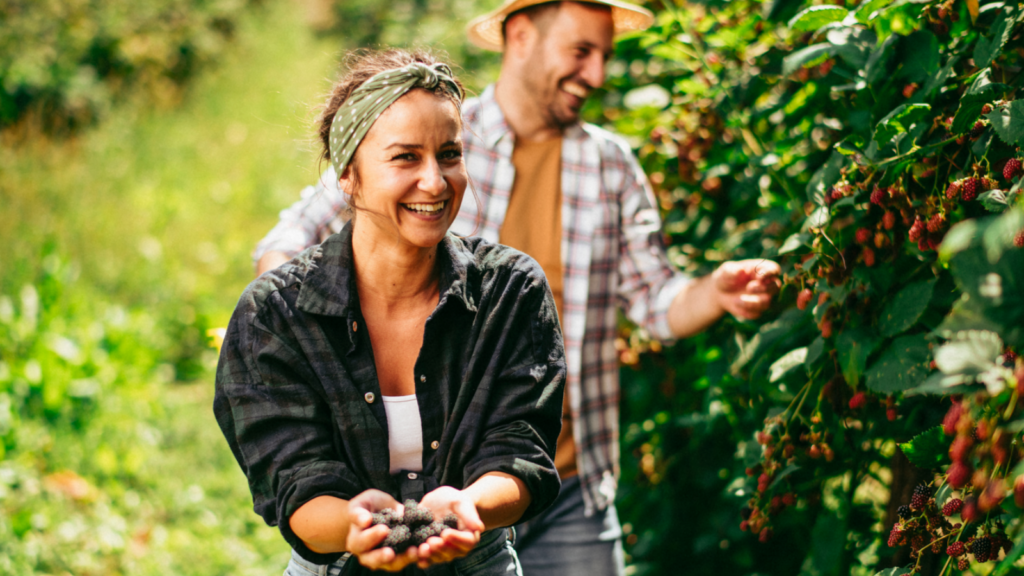Exploring a little of what foragers fancy on a date
Friday, June 16th, 2023

Hedgerow foraging is fast becoming one of our favourite countryside dates with plenty of outdoorsy singles pitching the idea to their muddy match.
Sharing the adventure of culinary exploration in the nation’s 400,000 miles of hedgerow brings out the adventurous side in people. Fans say it is liberating, and taps into the sustainable, self-sufficient lifestyle that many of those online dating with us find so appealing.
With the wild food movement and foraged foods becoming such a new trend too in message exchanges between rural singles, we thought we’d explore the variety of edible plants, berries, nuts that are the fancy of foragers.
Chickweed
Common in moist and shady areas of hedgerows and fields, chickweed has a small tender leaf with a mild flavour reminiscent of spinach. It makes a great pesto but can eat straight from the plant.
Blackberries
The foragers favourite. Hedgerows are abundant with blackberry bushes, and you can harvest the ripe betters in late summer and early Autumn.
Wood sorrel
Found in damp, acidic soil in woodland, and with a tangy lemony flavour, wood sorrel has a distinctive three-lobed clover-liked leaves with pink and white flowers.
Wild garlic
Both the leaves and flowers of wild garlic are edible and have a strong garlic flavour. Slightly sweeter than you may expect, it grows in more shady areas of hedgerows.
Sloes
The fruit of the blackthorn tree, sloes are small bluish-black berries that ripen in Autumn. They are widely picked to make slow gin and other liqueurs but watch out they can be somewhat bitter.
Elderberries
Elderberry bushes are another staple find in hedgerows, producing small dark purple berries in late summer and early spring. They are best pressed for a syrup, cordial or even wine. Best still, have you tried an elderflower fritter?
Hawthorn berries (Haws)
Harvested in Autumn and picked with great care from the hawthorn shrubs, these small red berries, are rich in nutrients but a little tart. They make a nice jam though.
Hazelnuts
Look out for hazel trees, which produce delicious round, brown nuts with a hard protective husk in the autumn.
Nettle tops
Though stinging nettles may not sound appealing; their young shoots and leaves are edible and highly nutritious when cooked to lose their sting. They are best harvested in spring before they become too fibrous and are a good substitute for spinach.
Sweet Cicely
A unique, acquired taste, but the fern-link leaves that surround the cluster of small white flowers have a super sweet aniseed flavour. Likely foraged on woodland edged hedgerows in shade, its seeds can also be used as a natural sweetener.
Horse parsley
Dark green and glossy with yellow-green flowers, the young shoots, leaves and seeds of horse parsley can be used in soups and stews. Once a popular vegetable, and commonly found in hedgerows nearer coastal areas, it has a strong distinctive flavour and scent.
Foraging together on an outdoors date is an excellent chance to get to know each other and explore each other’s connection to the countryside. It also provides ample opportunity to gauge your match’s personality and character.
However, it is important to identity plants accurately, take only what you need, and respect rights of way.
- blackberries
- country connections
- country couples
- country dating
- countryside connections
- countryside date ideas
- countryside dating
- dating advice
- foraging date
- hedgerow foraging
- muddy mates
- muddy news
- muddymatches
- online dating
- outdoor date ideas
- outdoor dates
- outdoor singles
- rural dating
- rural friends
- rural singles
- unique date ideas


